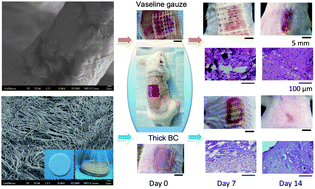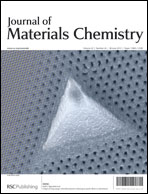Skin tissue repair materials from bacterial cellulose by a multilayer fermentation method†
Abstract
Using an improved method, the multilayer fermentation method, bacterial cellulose (BC) was produced by Gluconacetobacter xylinus. The structure and morphology were analysed by an electronic microscope. The surface area and tensile strength were characterised. In vitro, the cytotoxicity of BC was determined by the proliferation, adhesion property, morphology, and viability of human adipose-derived stem cells (hASCs). Full-thickness skin wounds were made on the backs of 35 mice. The wounds were subsequently treated with two types of gauzes, two types of BC films, and three types of skin grafts using 5 mice per group, respectively. The improved method was reproducible and more efficient to control the thickness and homogeneity of BC. Low cytotoxicity of the BC film and good proliferation of hASCs on the BC film were observed. Histological examinations demonstrated significant fresh tissue regeneration and capillary formation in the wound area in the BC groups on day 7 compared with those in other groups. Pathological studies also showed a faster and better healing effect and less inflammatory response in the BC groups than those in other groups. These results indicate high clinical potential of the BC biosynthesized by our improved method.


 Please wait while we load your content...
Please wait while we load your content...